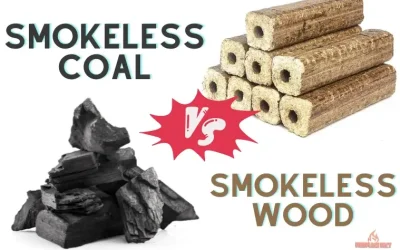Whether you’re thinking of buying a new smokeless fire pit, making your existing fire pit smoke “less” or trying to figure out an alternative for your multi fuel stove, you have to ask the question ‘What is the best fuel for a smokeless fire pit?’ Well luckily … .there are a few pretty good options to pick from
Overall, I pick Natural Fiber Logs is the best fuel for a smokeless fire pit and depending on your individual circumstances Bioethanol, Propane and Natural Gas can be picked as a second best. Although this will depend on a few factors like the type of fire pit you use and a few personal preferences like the setting you use it in, portability needs, where you live and of course cost, to name a few.
So, if you’re interested to know why I pick Natural Fiber Logs as the best fuel source for a smokeless fire pit, and how it compares against some of it’s top contenders, keep reading to figure out whether there is a different one that is best for you.
Best fuel for a Smokeless Fire Pit : Top 5
When it comes to fuelling your smokeless fire pit, the choice really comes down to a few of the most popular in the market and personal preferences!
There are about 7 popular fuel types that are commonly used in a smokeless fire pit. Bioethanol, Propane, Natural gas, Gel Fuel, Denatured Alcohol (hang on! I will explain in a bit), Natural Fiber Logs and Electric are the commonly used fuel sources.
But, all of them do not perform the same way and they all have their strengths and weaknesses. So here I would like to first laydown the top 5 that is worth spending your time reading on. Although, something to keep in mind is that all smokeless fuels are as good as the fire pit they are used in. So if you’re still considering buying or building a new smokeless fire pit, have a look at these articles to make sure you’ve got the right instrument at hand >> 11 Best Smokeless Fire Pits that’s trending Now and How Does A Perfect Smokeless Fire Pit Work.

1. Bioethanol
Picture this – a renewable, plant-based fuel that burns oh-so-cleanly, like a nature-loving fire dancer. Bioethanol is a popular pick for smokeless fire pits. It comes in liquid form, making it a breeze to use and control. With minimal smoke and a green thumbs-up, it’s a win for both your senses and the environment.
Strengths:
- It burns clean and emits minimal smoke, leaving nature untouched and your lungs singing with joy.
- It’s eco-friendly and renewable, making you feel like a true fire wizard.
Weaknesses:
- Abracadabra! Bioethanol may disappear faster than a rabbit in a hat.
- It has a higher consumption rate, so be prepared to replenish the fuel more often than you’d expect.
2. Propane
This fuel option brings convenience to the fire pit fiesta. Propane gas burns efficiently, whispering farewell to emissions while giving you instant heat like a magic trick. With portable tanks in tow, you’re ready to savour the warmth and keep the smoke in a distant memory.
Strengths:
- With easy-to-find tanks and simple ignition, it’s like a personal fire pit butler.
- It delivers instant heat and produces fewer emissions, keeping the flames roaring without a hitch
Weaknesses:
- Unfortunately, propane lacks the mesmerizing dance of traditional fire pits.
- The flames may not have that enchanting glow, but hey, you can always add some fairy lights to keep the ambiance alive!
3. Natural Gas
If you’re lucky enough to have a natural gas supply, it’s like having your own fire pit genie granting smokeless wishes. Natural gas is the clean-burning superstar, offering minimal smoke and soot. Just remember, to ensure safety and proper connections, it’s best to call in the pros for installation.
Strengths:
It burns cleanly, leaving no trace of smoke or soot.
The controlled flame brings peace of mind, like a guardian angel watching over your fire pit adventures.
Weaknesses:
Keep in mind that natural gas requires professional installation and a designated spot.
It’s not the easiest fuel to transport or store. But once it’s set up, it becomes a reliable and steadfast companion.
4. Gel Fuel
Let’s get gelling! Gel fuel adds a touch of fun and simplicity to your smokeless fire pit adventure. It’s a gelatinous marvel that burns with finesse, creating minimal smoke like a pro. Whether you opt for pre-packaged cans or embrace your inner mixologist and pour it into designated fuel canisters, gel fuel makes your fire pit journey a breeze.
Strengths:
- It’s easy to handle, requires no special equipment, and burns without a puff of smoke.
- Just pop in a can or pour it into designated canisters, and let the flickering flames ignite the fun!
Weaknesses:
- Alas, the sprite’s magic has a shorter duration.
- Gel fuel burns faster than a playful giggle, so keep those cans stocked up if you want the party to continue into the night.

5. Denatured Alcohol
Denatured alcohol, also known as methylated spirits, is a highly flammable liquid fuel that burns cleanly with minimal smoke. It is commonly used in camping stoves and can be utilized in certain smokeless fireplaces designed for alcohol-based fuels.
Strengths:
- It’s lightweight, portable, and burns with a clean flame that won’t leave you gasping for fresh air.
- Pack it up, hit the road, and let the tales by the fireside unfold!
Weaknesses:
- The troubadour can be a tad temperamental.
- It has a shorter burn time, so be ready to keep refilling the tank to keep the fire’s melody playing. Don’t let the flames fizzle out before the story ends!
6. Natural Fiber Logs
Natural fiber logs are made from materials like compressed sawdust or coffee grounds. These logs are typically treated to reduce smoke production and can provide a smoke-free burning experience.
Strengths:
- They bring a touch of traditional charm to your fire pit experience.
- These logs are crafted from natural materials, burn with a lovely flame, and create that classic woodsy scent that takes you back to simpler times.
Weaknesses:
- Unfortunately, the nomad can leave behind ash and residue, requiring cleanup after the party.
- They also have a limited burn time
So there you have it! Each of these options brings its own flavor to the table.
Although, if you’re like me, you might be still confused as to which one to pick before we embark on unforgettable evenings of marshmallow toasting, cozy conversations and the joy that only a smokeless fire pit can bring, let me make a simple comparison of each fuel type and how they stack up against each other.

How to choose the Best fuel for a Smokeless Fire Pit for me?
Summary
In summary, there are many types of smokeless fuel that can be used in a smokeless fire pit, but the overall winner for the Best fuel for a smokeless fire pit goes to Natural Fiber Logs if you want a more wood burning ambiance. However, if your personal circumstances call for different needs, like lower costs, easier to handle and maintain, Propane, Bioethanol or Natural Gas can also become a good secondary option.













